
Chaim Mordechaj Rumkowski was the head of the Jewish Council of Elders in the Łódź Ghetto appointed by Nazi Germany during the German occupation of Poland.
Miriam Winter was a Polish Holocaust survivor and writer. She is known for her authorship of Trains: A Memoir of a Hidden Childhood during and after World War II, which explores not only her survival of the Holocaust as a 'hidden child' but also the psychological toll of keeping her identity hidden, even to herself, in post-World War II Poland.

The Łódź Ghetto or Litzmannstadt Ghetto was a Nazi ghetto established by the German authorities for Polish Jews and Roma following the Invasion of Poland. It was the second-largest ghetto in all of German-occupied Europe after the Warsaw Ghetto. Situated in the city of Łódź, and originally intended as a preliminary step upon a more extensive plan of creating the Judenfrei province of Warthegau, the ghetto was transformed into a major industrial centre, manufacturing war supplies for Nazi Germany and especially for the Wehrmacht. The number of people incarcerated in it was increased further by the Jews deported from Nazi-controlled territories.
The Holocaust has been a prominent subject of art and literature throughout the second half of the twentieth century. There is a wide range of ways–including dance, film, literature, music, and television–in which the Holocaust has been represented in the arts and popular culture.
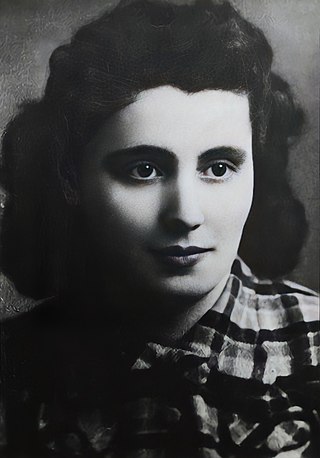
Malka Zimetbaum, also known as "Mala" Zimetbaum or "Mala the Belgian", was a Belgian woman of Polish Jewish descent, known for her escape from the Auschwitz-Birkenau concentration camp. She is also remembered for her lifesaving acts in favor of other prisoners during her captivity at Auschwitz and for the resistance she displayed at her execution following her being recaptured, when she tried committing suicide before the guards were able to execute her, then slapped the guard who tried to stop her, before eventually being killed. She was the first woman to escape from Auschwitz.
Lucjan Dobroszycki was a Polish scientist and historian specializing in modern Polish and Polish-Jewish history. A survivor of the Łódź Ghetto and Nazi concentration camps including Auschwitz, Dobroszycki lived in Poland after World War II where he obtained his education and worked as a historian. His main focus was the Nazi German occupation of Poland.

Lucille Eichengreen was a survivor of the Łódź (Litzmannstadt) Ghetto and the Nazi German concentration camps of Auschwitz, Neuengamme and Bergen-Belsen. She moved to the United States in 1946, married, had two sons and worked as an insurance agent. In 1994, she published From Ashes to Life: My Memories of the Holocaust. She frequently lectured on the Holocaust at libraries, schools and universities in the U.S. and Germany. She took part in a documentary from the University of Giessen on life in the Ghetto, for which she was awarded an honorary doctorate.
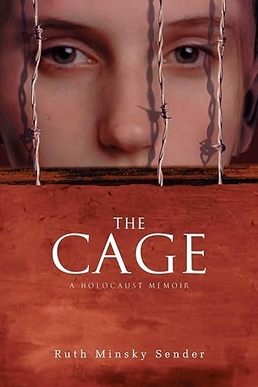
The Cage: A Holocaust Memoir is a book written by Ruth Minsky Sender in 1986, is a non-fiction book about the hardship and cruelty of being a Jew during the Holocaust. The book begins in 1986. Riva, who later changed her name to Ruth, is speaking with her daughter, Nancy, and she looks back to Lodz, Poland in 1941.
Außenarbeitslager Gerdauen was a subcamp of the Stutthof concentration camp in nowaday's Zheleznodorozhny, Kaliningrad Oblast. Most of the prisoners in the subcamps of the Stutthoff camp contained Jewish women from Hungary and from the Łódź Ghetto, and there were also some Jewish men from Lithuania. While a labor camp rather than a death camp, many people died - of 100 Jewish girls at the camp only three survived the war.
Elly Berkovits Gross is a Holocaust survivor and author of several Holocaust related books of poetry and prose. She currently resides in the United States, where she is a frequent invited speaker at museums and schools around the country.
Livia Bitton-Jackson was an author and a Holocaust survivor. She was born as Elli L. Friedmann in Samorin, Czechoslovakia, She was 13 years old when she, her mother, father, aunt and brother Bubi, were taken to Ghetto Nagymagyar. Eventually, they were transported to Auschwitz, the largest German concentration camp, where her brother and aunt were separated from Livia and her mother. Her aunt perished but her brother survived. She, her mother and brother were liberated in 1945. Bitton-Jackson came to the U.S. on a refugee boat in 1951 to join Bubi, who was studying in New York. She then studied at New York University, from which she received a Ph.D. in Hebrew Culture and Jewish History. She also wrote her 1997 memoir I Have Lived a Thousand Years.
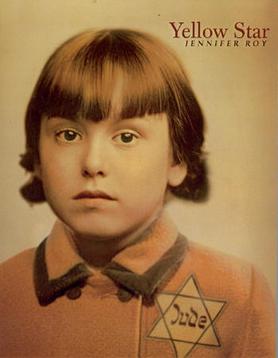
Yellow Star is a 2006 biographical children's novel by Jennifer Roy. Written in free verse, it depicts life through the eyes of a young Jewish girl whose family was forced into the Łódź Ghetto in 1939 during World War II. Roy tells the story of her aunt Syvia, who shared her childhood memories with Roy more than 50 years after the ghetto's liberation. Roy added fictionalized dialogue, but did not otherwise alter the story. The book covers Syvia's life as she grows from four and a half to ten years old in the ghetto. Syvia, her older sister Dora, and her younger cousin Isaac were three of only twelve children who survived. After the war, Syvia moved to the United States, married, and only much later told her story to Roy. Since its publication in 2006, the book has received multiple awards, starred reviews, and other accolades, and has been made into a likewise well-received audiobook.
Sara Zyskind, alsoSara Plager-Zyskind, was a prominent Polish–Israeli writer on the Holocaust. She was a survivor of the Łódź Ghetto, and of the Auschwitz, the Mittelsteine concentration camp, and the Grafenort Nazi concentration camps. Her style as a writer on the Holocaust has been praised for its effective literary technique that allows the reader to identify with the reality of the period. Her writings constitute valuable primary sources in Holocaust historiography.

The Mittelsteine concentration camp was a Nazi Arbeitslager or slave-labour camp functional on the territory of Nazi Germany during the latter part of the Second World War.
It was originally established in 1942, but was operated formally for 250 days between 23 August 1944 and 30 April 1945 as an all-female subcamp of Gross-Rosen.
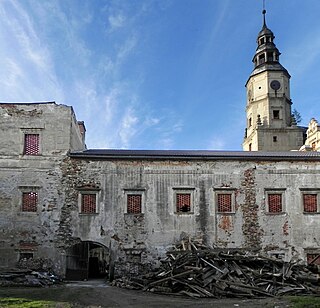
The Grafenort concentration camp was a subcamp of the Gross-Rosen concentration camp located in a castle in the village of Grafenort in Lower Silesia, which was operational throughout World War II. For 68 days from 1 March 1945, the camp was run exclusively as a women's subcamp, with between 250 and 400 female prisoners of Jewish ethnicity transferred from the Mittelsteine concentration camp. The reason behind the liquidation of Mittelsteine and the transfer of prisoners has not been fully understood. The prisoners at Grafenort were subjected to slave labor, building fortifications against the advancing Eastern Front of the Allies, and were known for receiving the most brutal treatment of any Nazi female concentration camp. The camp was liberated on 8 May 1945 by Soviet forces, and while some sources give different dates for the liberation, all Gross-Rosen subcamps were liberated between 8 and 9 May.

Vladka Meed was a member of Jewish resistance in Poland who famously smuggled dynamite into the Warsaw Ghetto, and also helped children escape out of the Ghetto.
Rywka Lipszyc was a Polish-born Jewish diarist and Holocaust survivor. She was deported to Auschwitz-Birkenau concentration camp followed by a transfer to Gross-Rosen and forced labor at its subcamp in Christianstadt. She was then taken on a death march to Bergen-Belsen, and was liberated there in April 1945. Too ill to be evacuated, she was transferred to a hospital at Niendorf, where the record of her life ended.
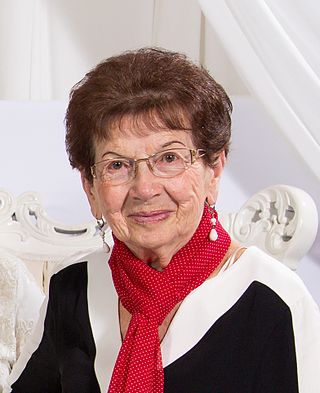
Bat-Sheva Dagan was a Polish-Israeli orator, psychologist, and writer. A Holocaust survivor born in Łódź, Poland, she was incarcerated in a ghetto in Radom with her parents and two sisters in 1940. After her parents and a sister were deported and murdered in Treblinka in August 1942, she escaped to Germany, but was discovered, imprisoned, and deported to Auschwitz in May 1943.
Margot Cecile Heumann was a German-born American Holocaust survivor. As a lesbian, she was the first queer Jewish woman known to have survived Nazi concentration camps.
Helen Colin, born Hela Goldstein was a Jewish survivor of the Holocaust. On April 24, 1945, she gave the first audio-visual testimony provided by a Holocaust survivor.









